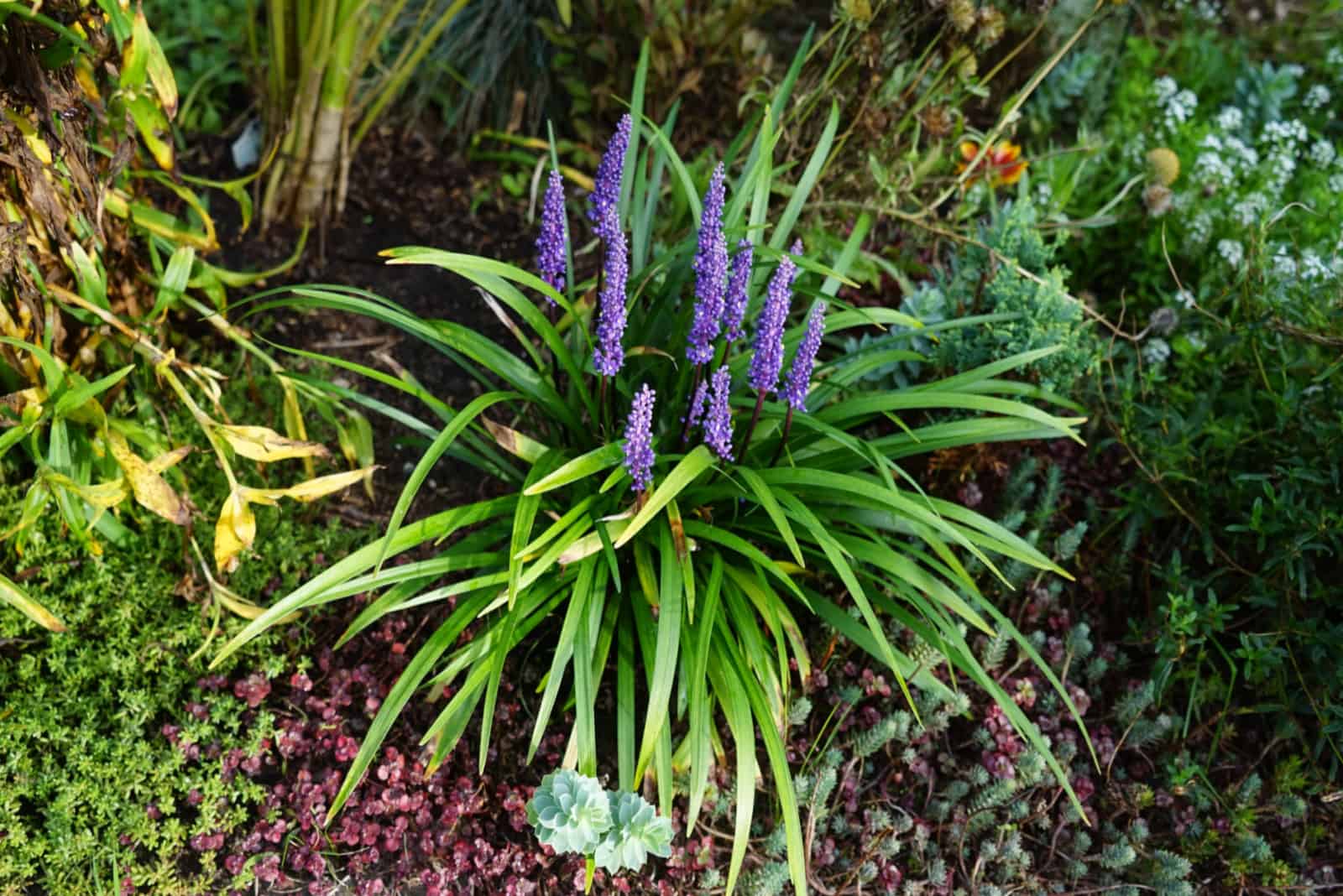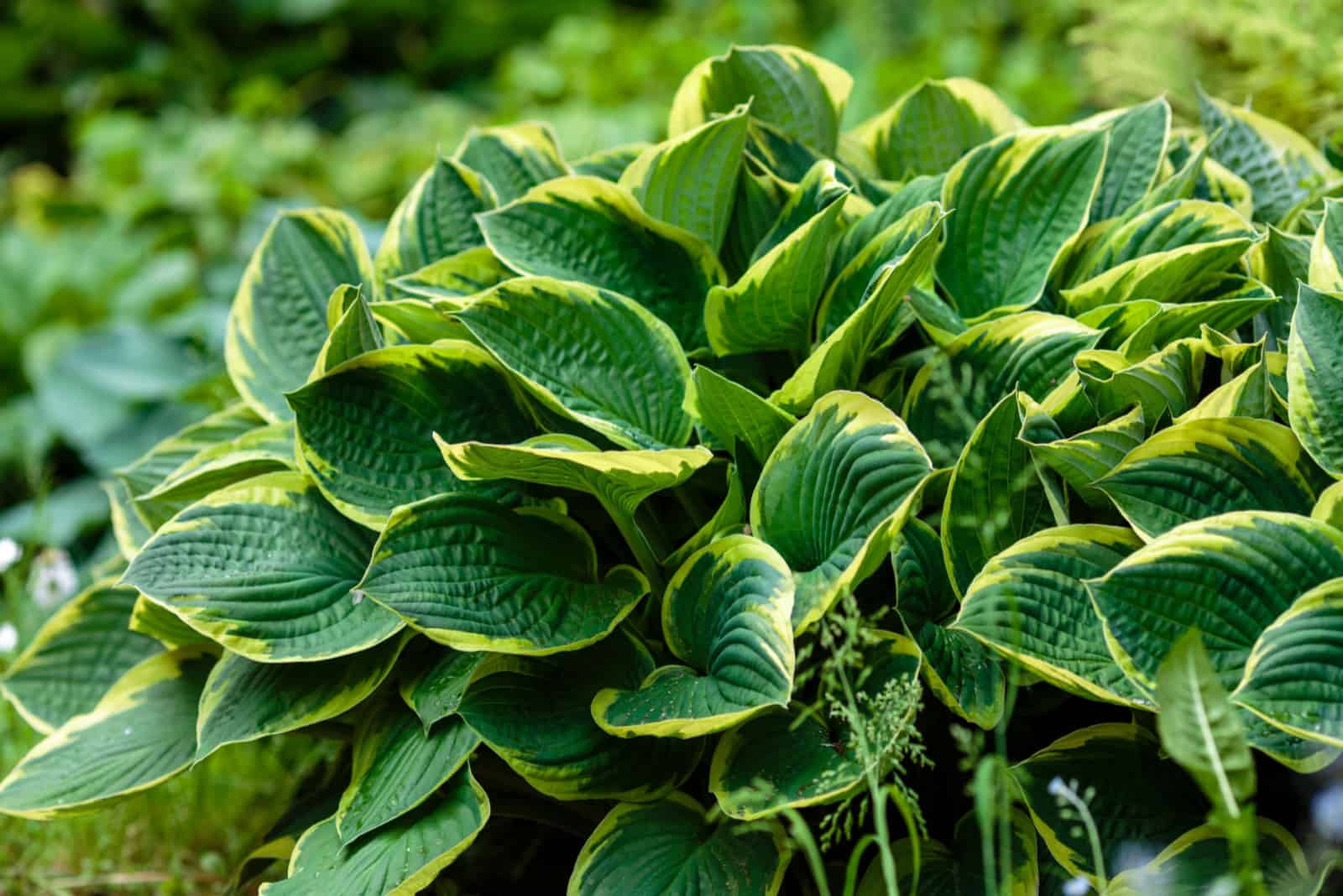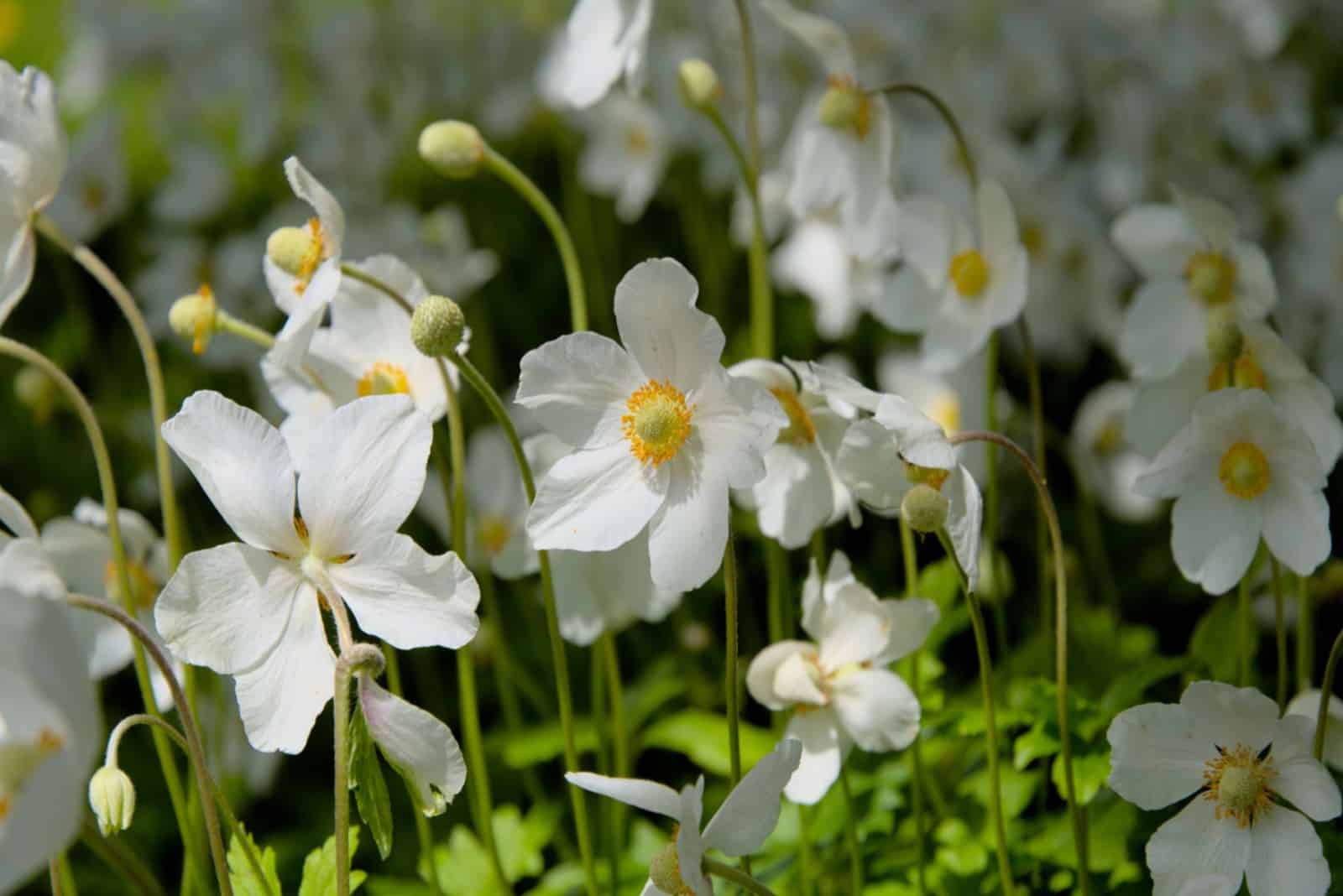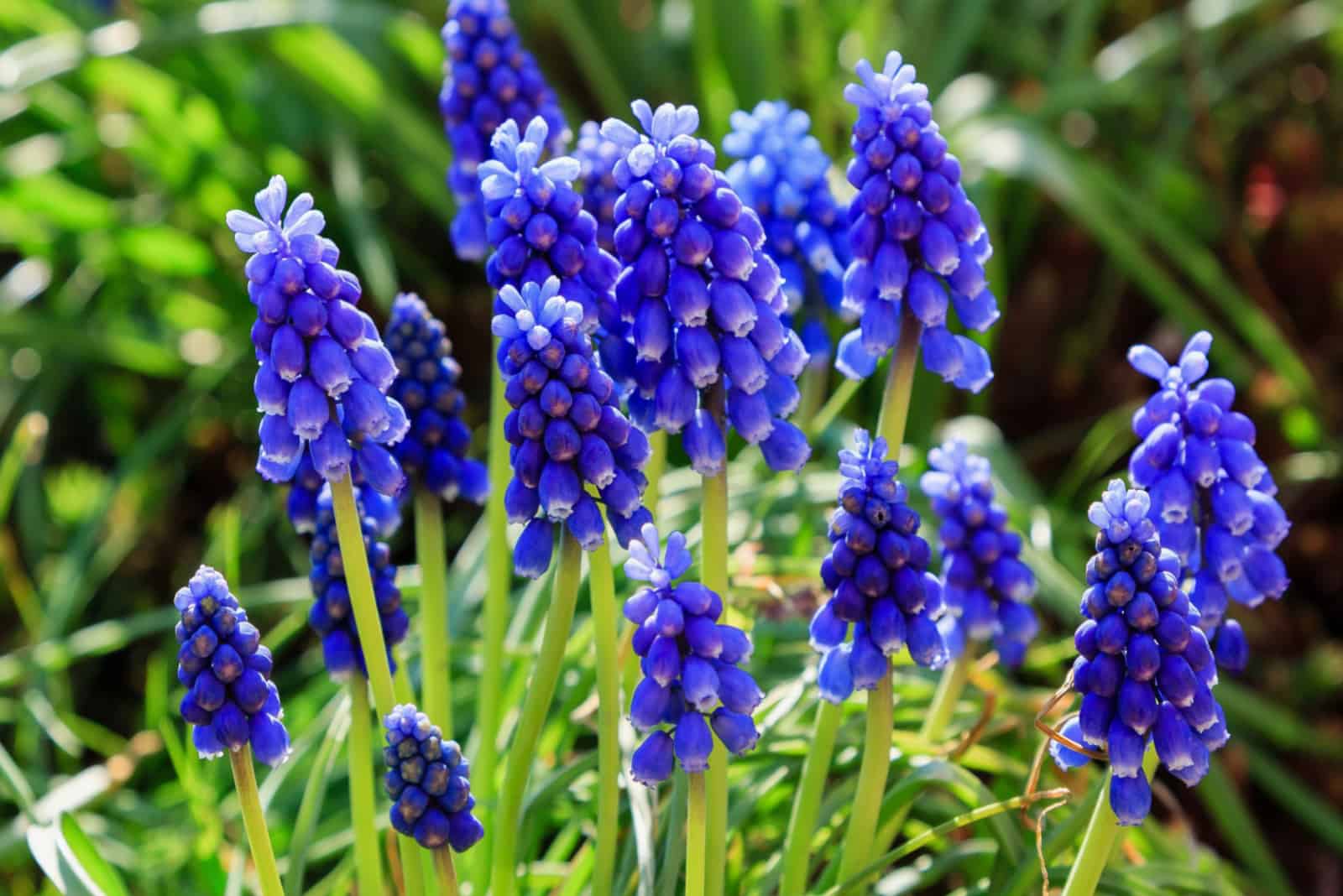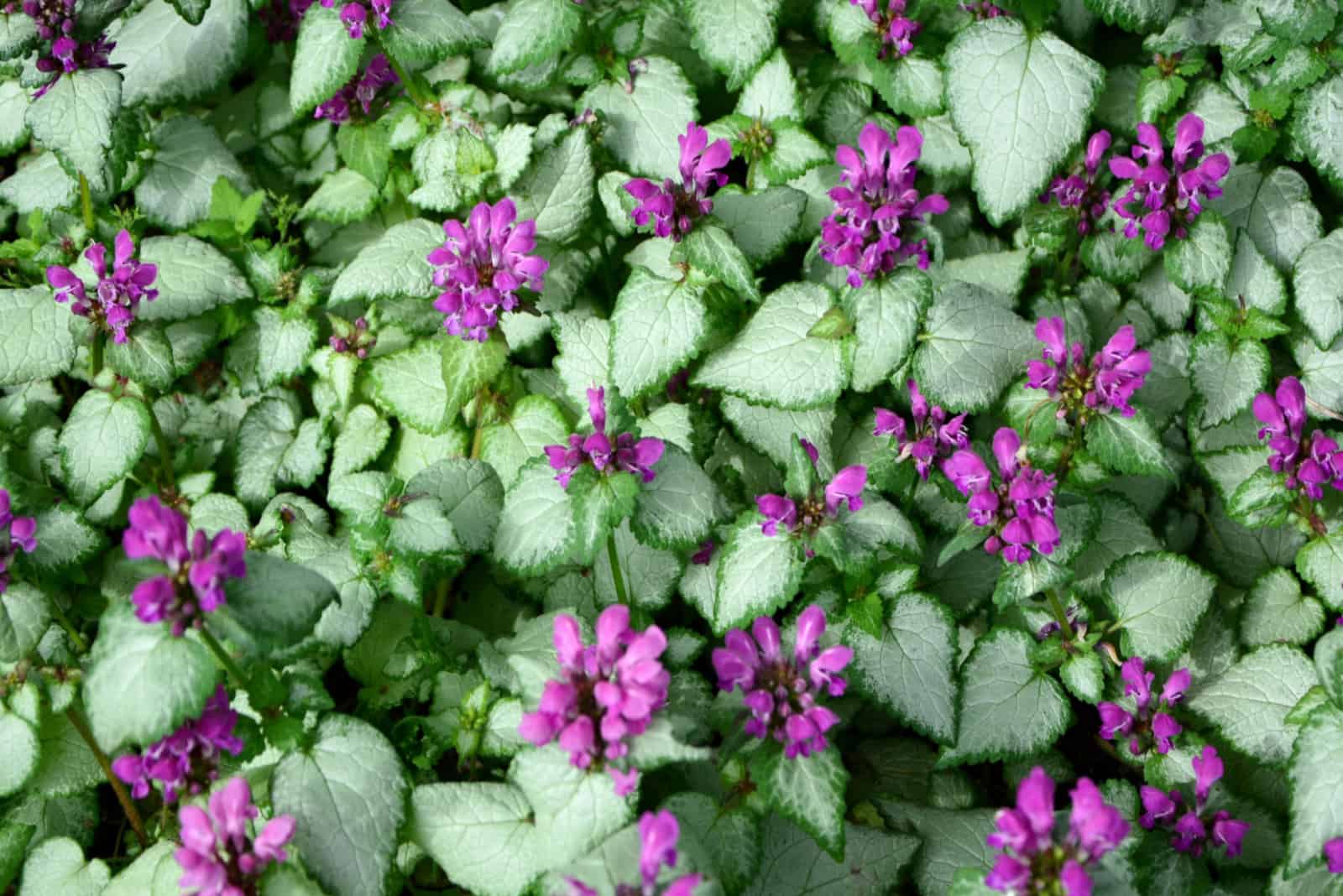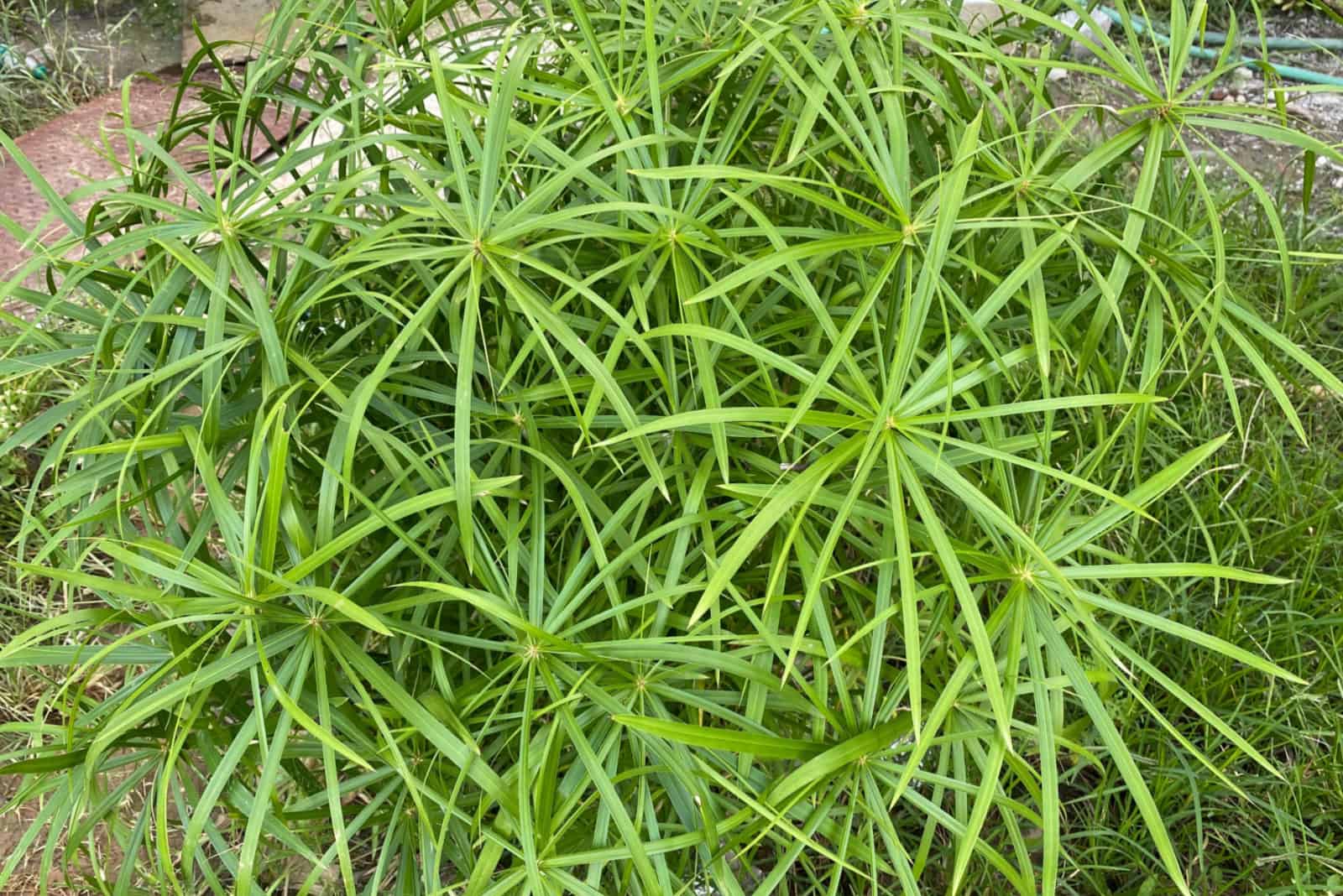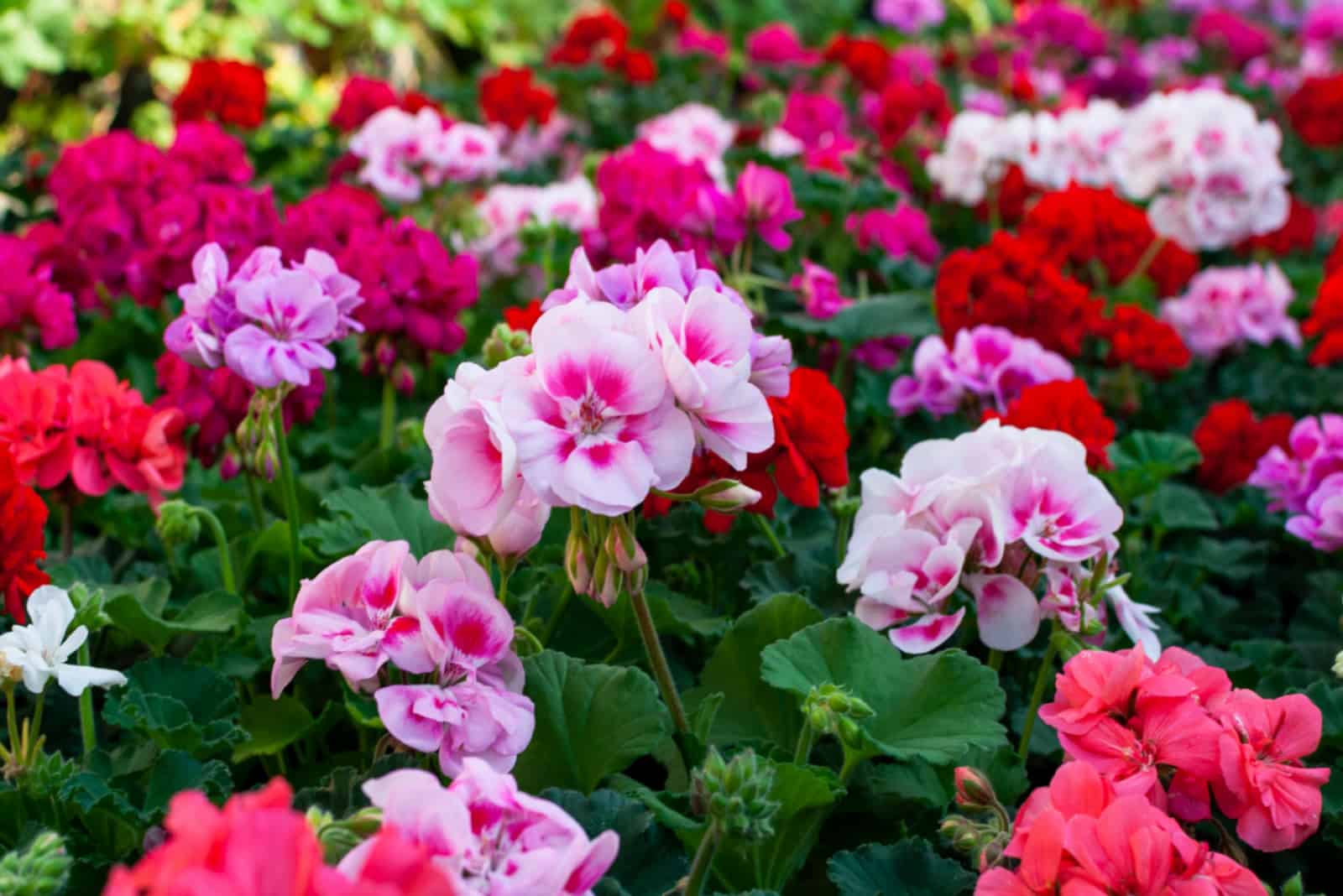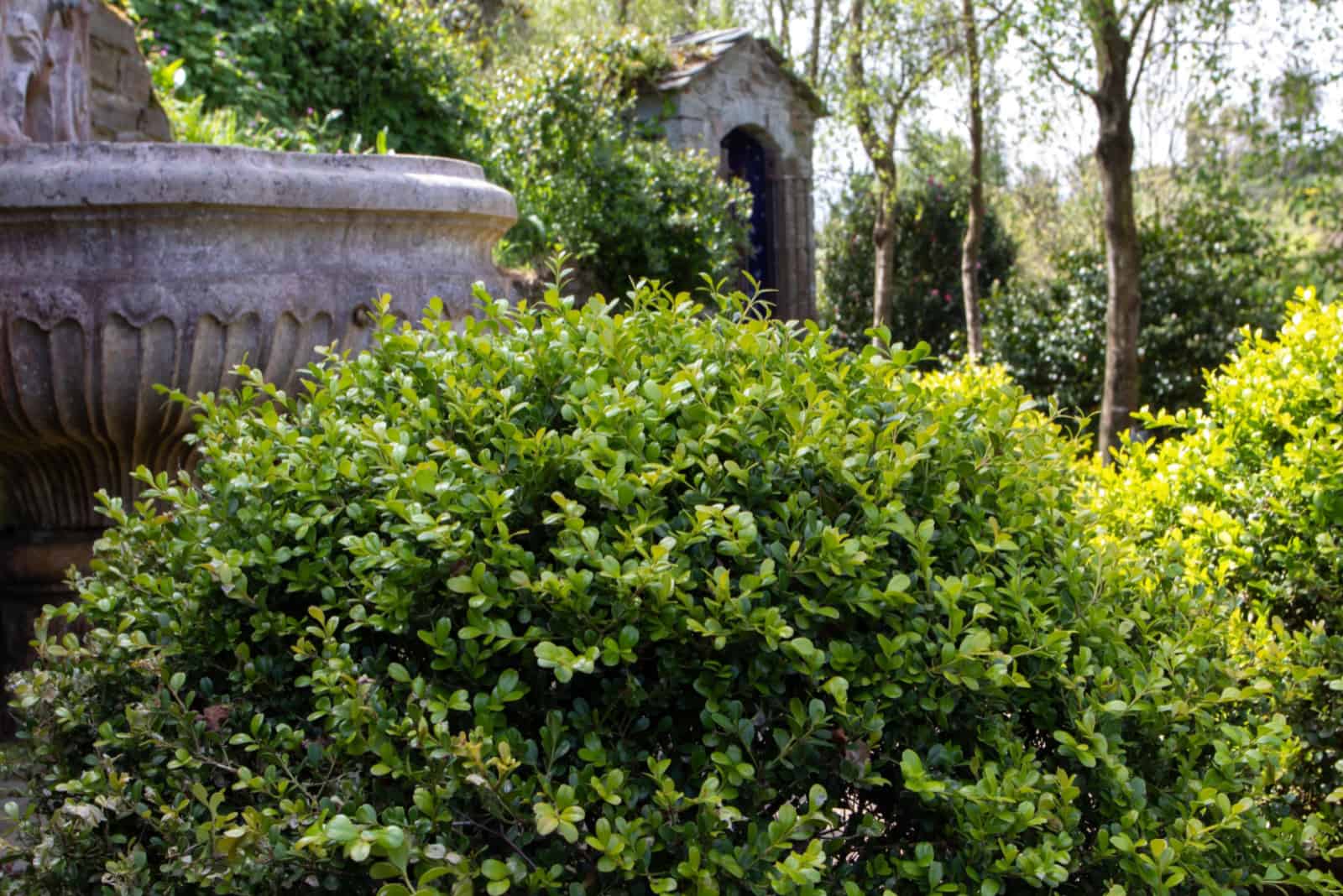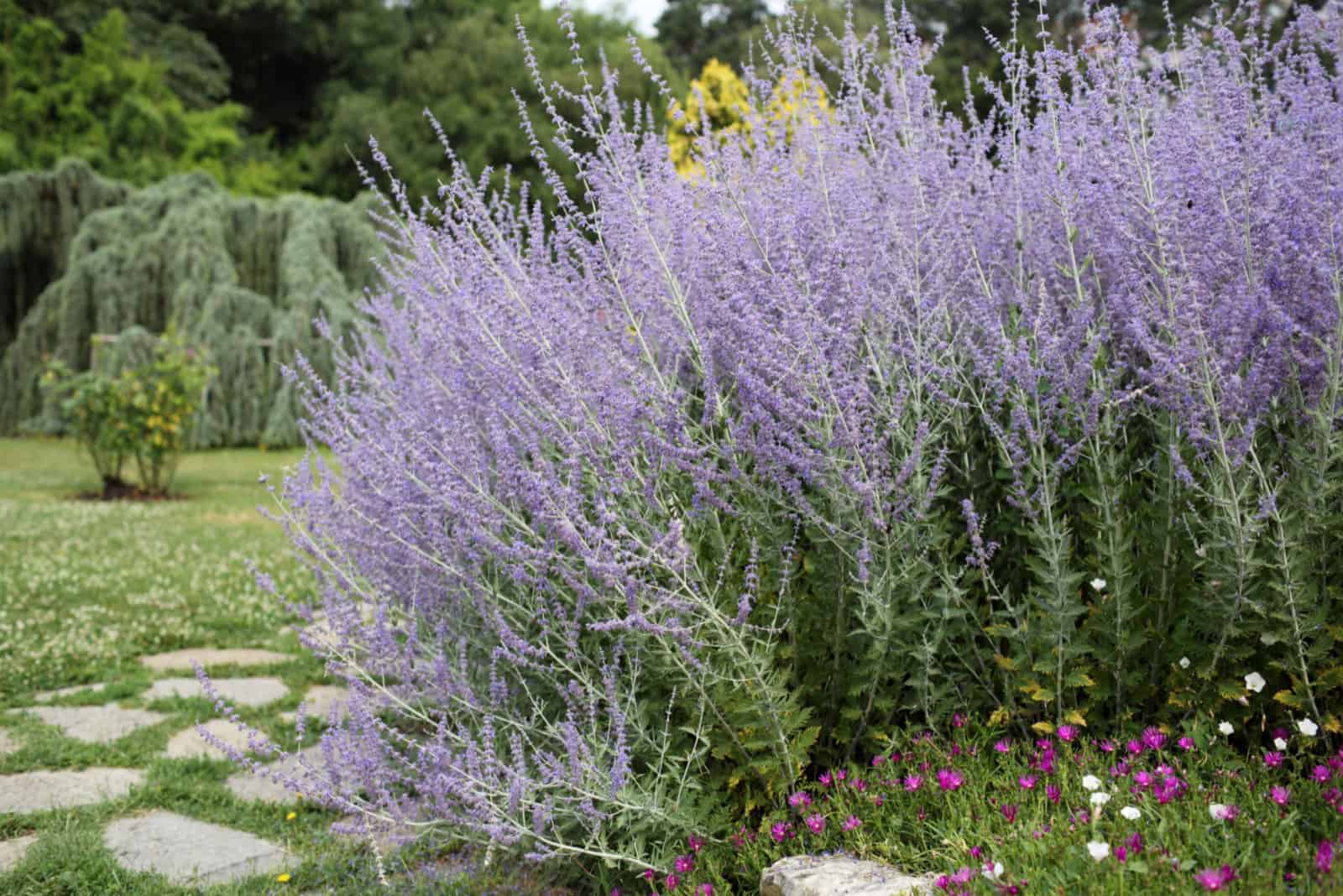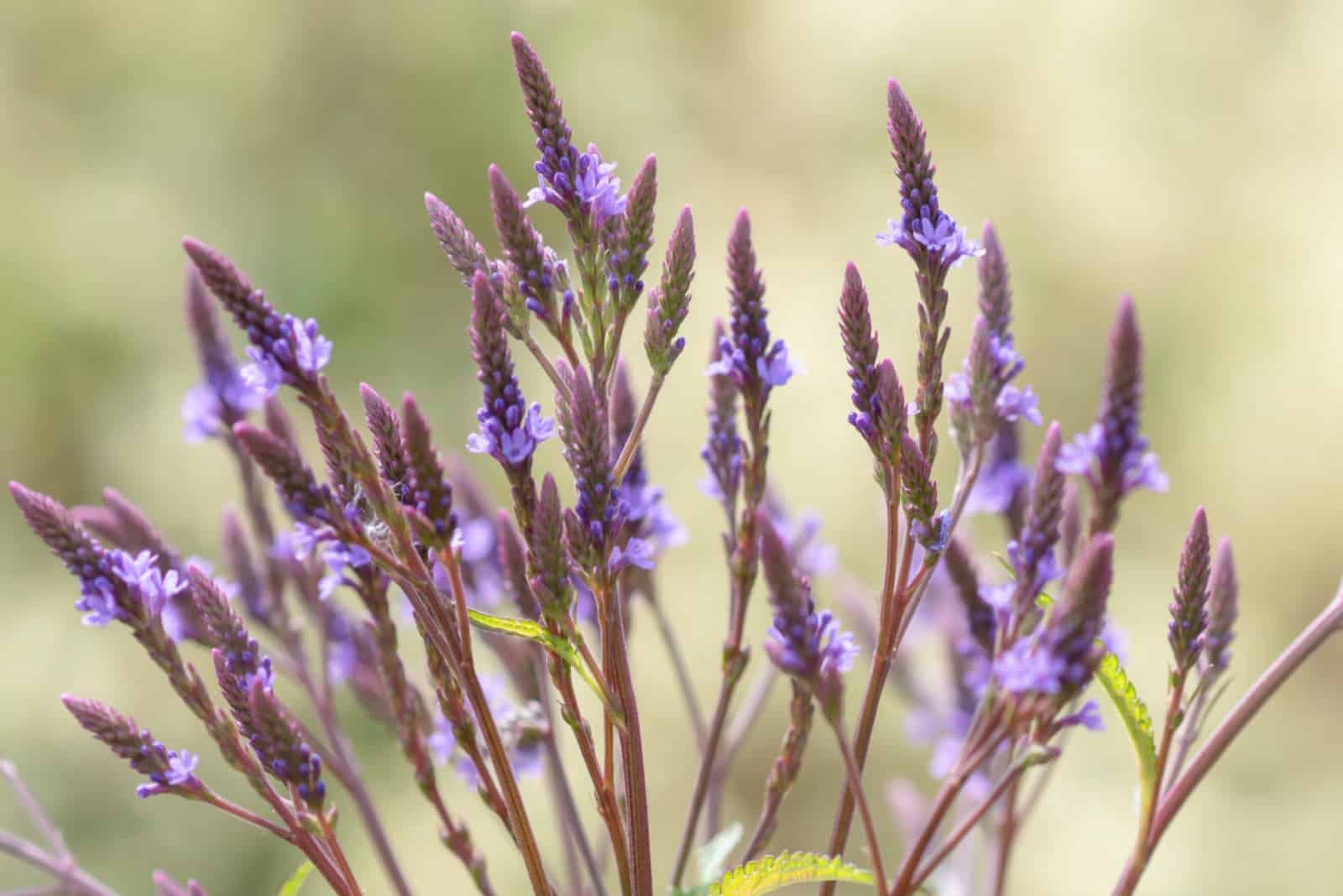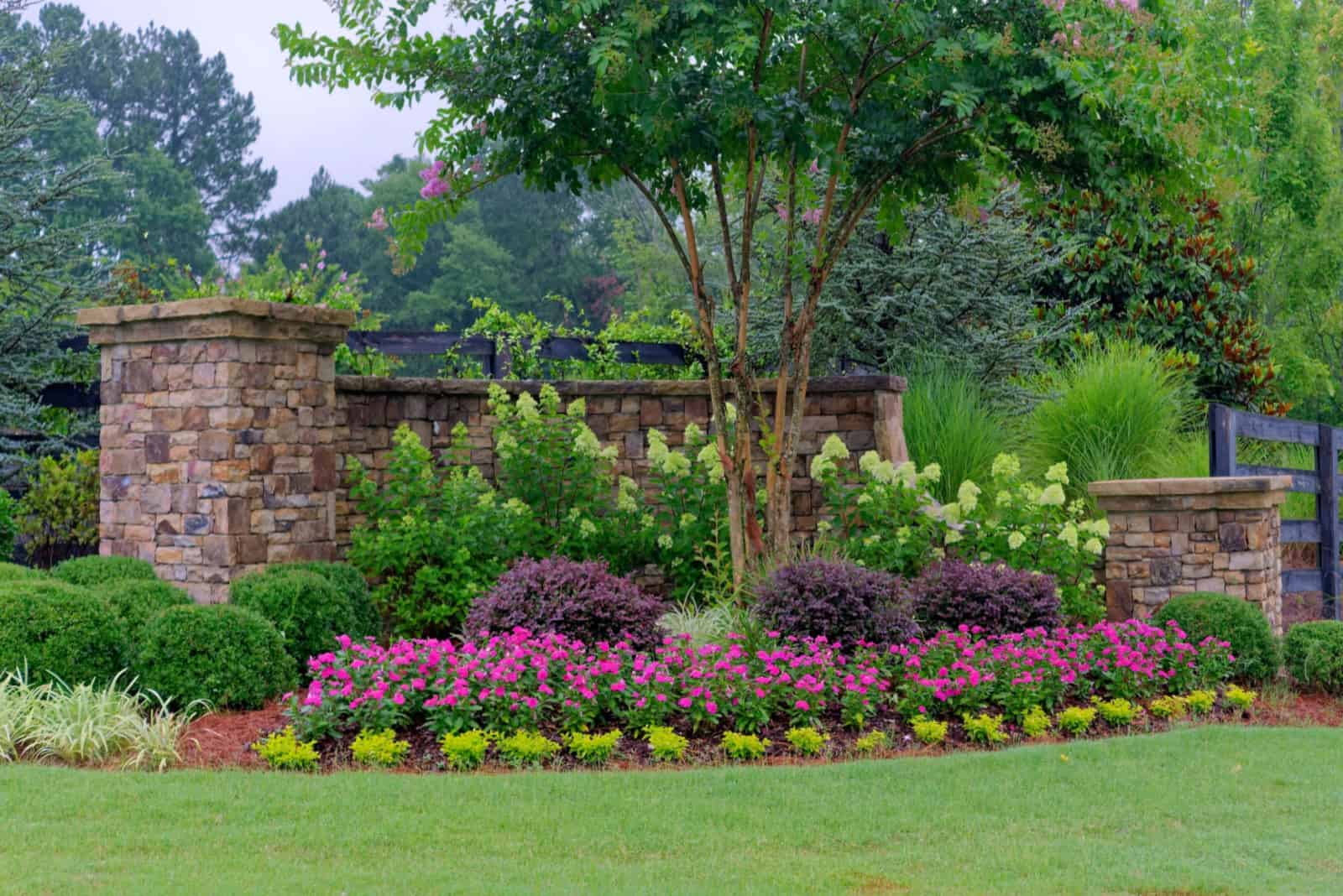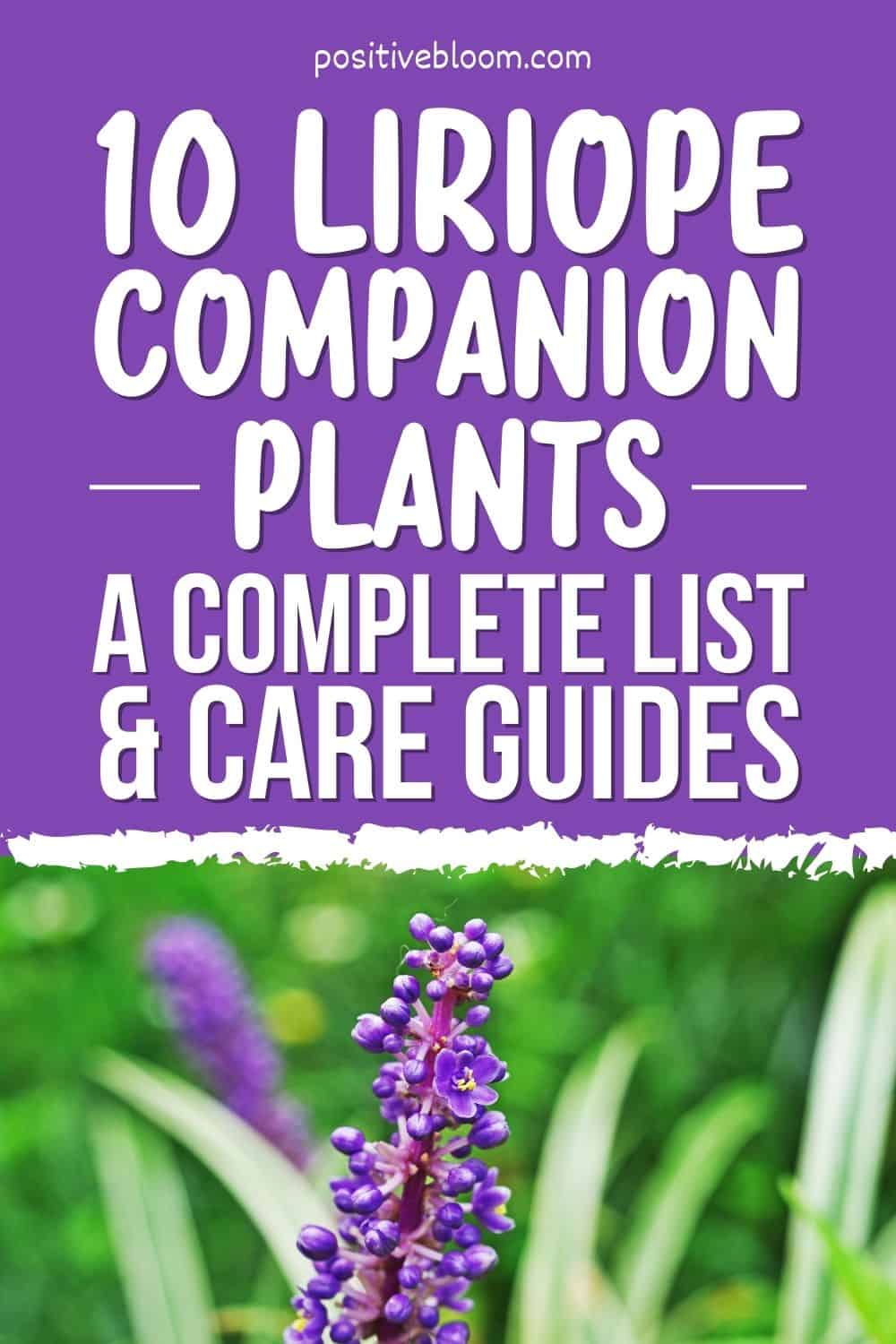Liriope, also known as monkey grass , has many different varieties. It’s one of the best choices for ground cover , but sometimes we want to add just a splash of color to our green landscape.
Thankfully, there are various colorful liriope companion plants that can bring out the best in each other.
We’ll talk more about those plants in a minute, but first, let’s look at some basic info about monkey grass:
[table id=240 /]
10 Liriope Companion Plant Ideas
Liriope is commonly seen in many landscape projects and designs, but it is often confused with mondo grass. Both of them have similar needs and looks, so it’s not surprising that people often struggle to tell them apart.
There are differences between monkey and mondo grass in terms of their size, color, and varieties, so you’ll be able to recognize which is which in no time once you do a little research.
This plant’s hardiness zone is 5-10, and there are different varieties and cultivars that might not even look like distant cousins. There are two main species: Liriope muscari and Liriope spicata .
For instance, variegated liriope ( Liriope spicata ‘ Variegata ’) doesn’t resemble Liriope muscari , otherwise known as lilyturf .
But don’t worry because this article has everything for everyone, and you’ll definitely find a plant that will complement your monkey grass perfectly!
1. Hosta
You may have heard others refer to this plant as plantain lilies, but the name is less relevant than its looks and requirements. Hostas have white and cream blossoms that go perfectly with Blue lilyturf ( Liriope muscari ‘Majestic’), and together they make an amazing contrast and add depth to your backyard.
Let’s check the main features:
[table id=241 /]
The ASPCA considers hosta toxic to pets , but its clumps , vivid foliage, and attractive flowers on long stalks make it hard to resist. The most common leaf color for this plant is a buttery yellow, but you can find it in a range of colors, including deep green and even powdery blue.
Hosta is hardy in zones 3-8, making your winter chores easier as you won’t have to think of ingenious ways to protect it.
How To Grow Hosta
Hosta doesn’t tolerate too much light and prefers morning sun to scorching afternoon sun rays , but as liriope can grow in almost any light conditions, it doesn’t matter where you place it.
You can even plant it below some trees, just make sure they have deep roots so that they push this plant out.
Hosta is a low-maintenance plant, just like liriope, but it will need frequent watering in the early days. You should irrigate it every day for the first couple of weeks after planting, but once it’s established, you can water it once a week , just like your monkey grass .
Both hosta and lilyturf love fertile growing mediums, so you should amend your garden soil with some compost to increase drainage. Neither of these plants can thrive in sandy substrates!
These plants even have the same fertilizer needs, and you can feed them twice a year with a slow-release fertilizer such as triple 10.
2. Snowdrop Anemone
The snowdrop anemone is one of the most attractive varieties of this genus, and its white flowers are a perfect match for a Big Blue liriope.
Here are the general specifics about this plant:
[table id=242 /]
All anemone plants are toxic due to anemonin, but once this variety opens its pure, delicate blossoms in spring (or even in early fall if the days are cool enough), you’ll need to take some extra caution.
The snowdrop anemone is a cold- hardy plant that grows best in USDA zones 3-8, so you don’t have to worry about protecting it once the temperatures drop below freezing.
How To Grow
Contrary to other varieties, this plant prefers partial to full shade . Thankfully, liriope can handle full shade conditions without trouble, so you can grow these two plants side by side.
The snowdrop anemone has moderate water needs and grows quickest in mildly moist, well-draining soils. It can easily get invasive, especially if grown in sandy soils, but you can always grow it in slightly heavier mediums and reduce its spreading ability.
You can always grow this plant as ground cover , edge the area with some liriopes, and create a garden worthy of a fairy tale.
Amending the soil with humus is an excellent way of improving drainage and giving your plant all the nutrients it needs.
You should water it once a week to maintain the soil moisture , but you don’t have to fertilize it regularly – especially if the growing medium is rich with nutrients and organic content.
However, you can always sprinkle some slow-release fertilizer or add some bone meal. Feed the fall bloomers in spring and spring bloomers in fall to encourage the best flowers.
3. Grape Hyacinth
This flower will adorn your garden with its attractive white, yellow, blue, or purple flowers in early spring .
Let’s look into its specifics:
[table id=244 /]
Grape hyacinth and liriope plants are perfect companions as they are both pet-friendly and can create a nice contrast to your rock gardens .
The preferred hardiness zones for this plant are between 3-9, which means it can handle extremely low temperatures. However, as liriope isn’t that hardy , you shouldn’t grow it in zones below 5 or 6.
How To Grow
This hyacinth can tolerate both sun and shade, but it thrives in partial shade , which makes its blooms last longer. Of course, it makes no difference to the dark green foliage of the liriope.
Its water needs are quite simple, and you only need to irrigate it once a week to maintain a slightly moist growing medium.
This easy-to-care-for plant doesn’t have many requirements, but you should be mindful of the soil type you grow it in. Make sure the substrate is well-draining – but as monkey grass has the same need, it shouldn’t be a problem.
You can always add some compost based on loam to improve drainage and add some organic material.
You don’t have to feed this plant additionally as it benefits from the compost tremendously. Just add some compost in spring to keep it happy for the entire year.
You can use high phosphorus fertilizers once before and after blooming , but don’t fertilize this plant too often.
4. Dead nettle
Planting Lamium (dead nettle) deliberately never occurred to me, but once I saw how amazing they look in flower beds and edging walkways, I changed my mind.
Here’s the main info:
[table id=245 /]
Drizzles of pink, purple, or white flowers protruding from the green leaves appear in late spring and add a dash of color to your garden.
This plant grows in zones 4-10, which are almost the same as the USDA zones for liriope. (I mean, if that’s not a sign to try it, I don’t know what is!)
How To Grow
Lamium thrives in part shade or even full shade , but it can tolerate a little bit of light. Thankfully, monkey grass isn’t picky about its lighting conditions and can grow pretty much anywhere – from full sun to full shade.
This plant also thrives in moist (but not soggy) soils, so you should water it deeply. However, don’t irrigate it too often as it can lead to overwatering and root rot, which can kill your plant.
Lamium can grow in many soil types as long as the pH level is between 6.0-7.0 and is well-draining.
You can fertilize dead nettle with a general-purpose fertilizer twice a year , once in spring and then in summer – just like you would feed liriope.
5. Sedge
You might not be very keen to grow sedge , probably because you’ve dedicated a lot of time to eradicating this weed! However, it can be quite an addition to your garden and bring out the depth of liriope’s green foliage .
Let’s look into its general specifics:
[table id=246 /]
There are different sedge varieties, and if you want something to break the monotony of all-green liriope leaves, the variegated Japanese sedge is a great option .
There are also golden and orange variants such as Carex dolichostachya ‘Kaga Nishiki,’ whose showy , colorful blades can even improve ideas for a low-cost zen garden .
Another perk of this plant is that it’s deer-resistant , so if your region gets many attacks and your plants get bitten regularly, you can simply plant Carex plants, sit back, and enjoy your un-chomped greenery!
How To Grow
Sedge grasses are hardy in zones 6-9 and can grow either in sun-lit or shaded locations – it all depends on the climate and USDA hardiness zone .
If you live in a warmer region, you should plant this Carex in partial shade. If you live in a cooler area, ensure that it gets plenty of sunlight.
Watering this plant is simple, it’s not like maintaining a lawn. You should irrigate sedge plants once the top few inches dry out , which mainly depends on the temperature and humidity.
This grass is quite adaptable and can grow in fertile and rocky soils alike. However, it does need a certain level of water retention, so ensure that the soil is slightly moist and doesn’t dry out too quickly in the summer.
Carex plants epitomize the term ‘ low-maintenance’ , especially when it comes to their fertilizer requirements. They rarely need additional feeding and don’t require too much nitrogen.
You can fertilize them once a year in late spring or early summer to ensure even faster growth and development.
6. Blue Fescue ‘Elijah Blue’
Blue grasses are one of the most attractive plants for decorating your courtyard. This particular grass complements liriope perfectly, and they really bring out the best in each other.
Let’s look into its general information:
[table id=247 /]
Two ornamental grasses next to each other may seem like too much, but they really give a complete make-over to your winter garden .
Blue fescue ‘Elijah Blue’ is a vibrantly colored dwarf variety that blooms in June. It produces nuanced stalks that are blue at the base and become browner and browner towards the yellowish inflorescence.
It is an ideal companion to Big Blue lilyturf, which flowers early-to- late summer because their blooming times coincide. Even after the Elijah Blue stops flowering, its silvery-blue foliage can still contribute to the overall look and make the liriope’s flowers stand out even more.
How To Grow
This plant is a cool-season grass hardy in zones 4-8, so you can grow it in full sun conditions without worrying about sunburn.
It is drought-tolerant, and you should water established plants only when the heat is unbearable. Generally speaking, you should water it once a week in the summertime and then reduce the frequency and amount of water as the temperatures get lower.
This plant flourishes in poor or moderately fertile soils , and you will have no issues as long as they’re well-draining.
If you use organic mulch, you won’t have to fertilize it at all, but if the growing medium is really poor and you don’t mulch it, you can add some slow-release fertilizer in spring.
7. Geranium
The colorful blooms of geraniums can complement any liriope variety, but I personally love growing it with Liriope muscari ‘Monroe White’ because the vibrant colors of geraniums make this grass-like plant all the more attractive.
Here is the main info about geraniums:
[table id=248 /]
Another toxic and breathtaking flower is the geranium . It also has a long blooming season that begins in spring and lasts until fall if you meet all its requirements.
How To Grow
There are annual and perennial geraniums , and their light preferences all differ. For instance, annual geraniums adore the full sun, whereas perennials can handle either light or shade, depending on the type.
However, either of these preferences are fine with liriope, so it doesn’t matter which one you get.
It’s just that perennial geraniums are much hardier and can survive in USDA zones 3-9, which makes them the preferred choice of gardeners around the world.
Geraniums need moist soil to flourish, so water them whenever the topsoil dries. They’re easy to overwater, so don’t irrigate them more than necessary.
This plant prefers fertile, loose soils (just like liriope), and you can amend a heavy clay medium by adding compost. The geranium is on a list of plants that don’t like mushroom compost , so bear this in mind when modifying the soil.
Thankfully, there are specialized fertilizers for geraniums with an NPK of 15-15-15 (usually), and that might be too high for your liriope, but it could suit it just fine if the growing substrate is less fertile.
However, make sure to check the quality of the soil before applying any plant food, and try to limit the geranium fertilizers to just these plants.
8. Common Boxwood
Boxwood is the first thing that comes to mind when we think of hedges to fence our property. They’re also an excellent companion to monkey grass and can really transform your landscape into a monumental work of art!
Before we go on any further, let’s look into its specifics:
[table id=249 /]
The white or blue flowers of Liriope muscari cultivars make boxwood even more attractive, and once the black berries replace the blossoms, the colors blend and create a surface that’s soothing for the eyes and soul.
Common boxwood can grow in USDA zones 5-8, but the best growing conditions are in zone 7.
How To Grow
Boxwood prefers partial shade , and the best place for this plant is somewhere with plenty of sun in the morning and shade in the afternoon.
However, there are boxwood varieties that prefer deeper shade, and if you only have room for this plant on the north-facing side of the yard, you can always get Green Mountain, which can tolerate almost full shade conditions.
You should water newly planted shrubs once or twice a week during the first year, and then reduce watering to once per week as it gets more established. It’s a perfect match for your liriope as it also needs thorough irrigation weekly.
This plant can thrive in many soil types; alkaline or acidic, rich or poor – the only requirement is good drainage. You can either amend the soil with compost and organic matter or plant the boxwood on a berm. Either of these choices will increase drainage.
The best fertilizers for boxwood are slow-release, such as nitrogen-rich 10-6-4. You can always use organic fertilizers, just ensure they have enough nitrogen to meet this plant’s needs.
9. Russian Sage
The blue flowers of Russian sage go well with Monroe White or Big Blue lilyturf and create an idyllic space your body and spirit can relax in.
These are its main specifics:
[table id=250 /]
This drought-resistant plant is ideal for mass planting because its lavender-like scent will turn any area into a relaxing space.
You might even feel like planting lavender as well, and the good thing is that you can always research the differences and similarities between Russian sage and lavender and choose the best one for your region.
It is hardy in zones 4-9, so it can be grown side by side with liriope in many regions.
How To Grow
Russian sage needs full sun to thrive, so choose a location without tall trees casting a shadow over it. As it’s taller than liriope, you can plant it behind it and give your landscape some depth and texture.
It also doesn’t need too much water. Watering it twice a month is enough, just make sure your liriope doesn’t dry out in the meantime.
Russian sage can thrive in both clay and sandy soils alike , but liriope prefers loose and loamy substrates, so you should grow it in a medium that suits both plants.
The good news about this sage is that it doesn’t need rich soil, so you don’t have to fertilize it constantly and keep adding compost.
You can fertilize it every spring with a slow-release fertilizer, and it’ll be pretty happy.
10. Blue vervain
The last plant on our list is blue vervain, and it’s one of the most ideal plants for Liriope spicata . This variety of liriope is more invasive and spreads a lot faster than muscari, and the vervain can create a nice contrast rising above it.
Below you can find the main info about blue vervain:
[table id=251 /]
This plant isn’t included in the ASPCA’s list of plants toxic to cats and dogs, but it can still cause certain issues like vomiting and diarrhea, kidney pain, depression, and a sense of weakness if ingested in large quantities.
However, pets cannot eat enough of it to cause any serious issues and it isn’t usually fatal, so you don’t have to worry too much about having a few of these plants in your backyard.
Blue vervain is hardy in zones 3-9, and it produces dark purple-blue flowers on elongated, 5-inch long panicles in mid-to- late summer .
How To Grow
This plant needs full sun or part shade, which mostly depends on the temperature and climate in question.
If you grow it in a cooler region, place it in full sun as it won’t burn its beautiful foliage. If your home is in a warmer climate, you can always plant it in the eastern corner of your yard, where the afternoon shade can protect it from the scorching sun.
Furthermore, ensure that the soil is moist and check it every day. Monitoring your plant can help you avoid all sorts of problems such as wilting and burning. Never allow the soil to dry out , and give it some water as soon as you notice that the topsoil has somewhat dried.
Blue vervain thrives in loamy, well-draining soils, but it can grow in just about any medium as long as the drainage is suitable.
Verbena hastata is a heavy feeder and requires frequent fertilization throughout its growing season. Give it some plant food once or twice a month (depending on the concentration of fertilizer) in spring and summer.
FAQ
We have examined some common liriope companion plants , but we haven’t had the chance to talk about the monkey grass itself yet.
Therefore, we found some frequently asked questions about liriope and answered them to bring this ornamental grass closer to you.
Let’s begin!
Will liriope choke out other plants?
There are two types of liriope, but only Liriope spicata has the potential to choke out other plants. It spreads rapidly and can quickly become invasive and suffocate other plants.
Therefore, you should only use it in areas where you want to give full coverage or don’t grow any other plants, such as hillsides.
However, it is an excellent ground cover , and if you want to stop it from spreading uncontrollably, you can always place some barriers in the ground or grow them in containers buried in the soil.
Another way of growing this invasive liriope without having it take over your entire garden is by spreading some mulch or even treating the troubled areas with herbicides, bleach, or other weed killers.
On the other hand, Liriope muscari is a regular clumping variety, and you can safely grow it anywhere you like.
Does liriope prefer sun or shade?
Liriope can thrive in full sun and shade, although it prefers areas with part shade .
Of course, if you grow it in full sun, you should water it more frequently than if you grow it in a dark spot.
What is the best type of liriope to plant?
It really depends on your needs; if you want a new ground cover quickly, you should grow Liriope spicata .
However, this variety is unpredictable, sends shoots everywhere, and will overtake any space.
Liriope muscari is much easier to manage, in fact, it’s very easy to control and forms beautiful clumps that stay put. It’s up to you to decide how fast you want it to grow and whether you’re willing to sacrifice some plants as spicata can choke them.
Summing Up
This article brought ten different liriope companion plants that can emphasize this plant’s vivid foliage and bright flowers.
We discussed their care guides in short so that you know how to grow these plants if you decide to beautify your landscape even more.
We also answered some basic questions about liriope and presented the main differences between Liriope muscari and spicata to help you weigh all the pros and cons and choose the perfect one for your garden.
Happy planting, and until next time!
Like this post? Share or pin it for later!

